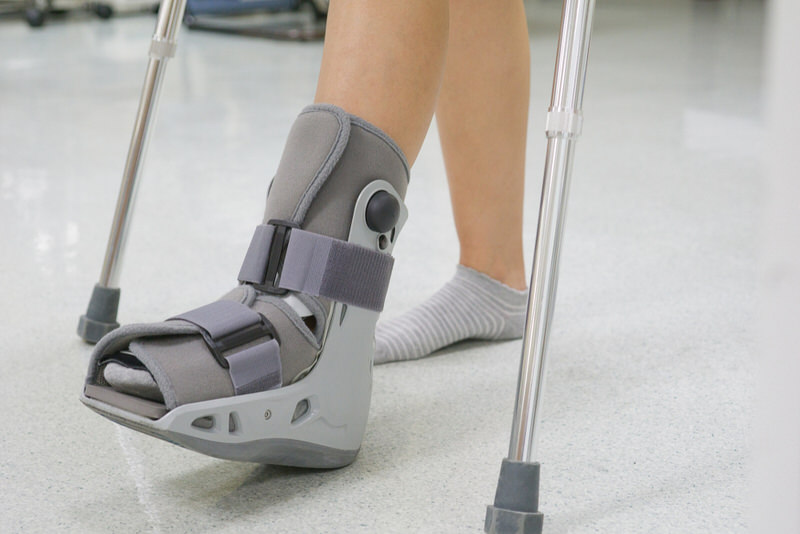Crutches and orthopedic walking boots are two examples of walking aids that help injured people recover while being able to move around on their own. The nature of the injury determines how long crutches and walking boots are used, although this commonly takes 2 to 6 weeks.
Initially, most patients are advised to use both walking boots and crutches, gradually increasing the weight placed on the injured foot or leg. When the leg can handle the person’s whole weight, it can be shifted to using a walking boot, sometimes with just one crutch or a cane.
Sometimes, the transition may be uncomfortable or painful, especially on the muscles and skin of the foot, but proper care and regular movements can help.
All of you probably know someone who got into an accident, big or small, and ended up wearing a cast or using crutches for a few weeks.
Although it’s difficult to say which injuries are the worst, it’s clear that foot and leg injuries are particularly tough to handle, simply because it’s hard to walk afterward.
Part of the rehabilitation process is using various walking aids to get back into shape, such as crutches and orthopedic boots.
What are crutches and walking boots?
Crutches are a temporary replacement for an injured leg. They help a person move from point A to point B by receiving weight (and pressure) that is typically carried by the legs while walking.
With crutches, you can place some or completely none of the body’s weight on the injured leg. This depends on the type of injury you’ve had and the treatment you’ve received.
Severe fractures and injuries usually require no weight on the affected leg (non-weight bearing), while less serious injuries may permit some weight (weight-bearing).
Walking boots are one of the other types of walking aids; it’s referred to as “orthopedic walking boots” or “orthopedic boots.”
These are specialized boots with adjustable straps and cushions that help keep the foot in the proper position as a patient adjusts to normal walking habits.
These boots may be used with or without crutches. A person may use both mobility devices during rehabilitation before easing into using a walking boot, with or without one crutch.
In the beginning… how crutches and walking boots are used
Usually, at the start of the rehabilitation process, crutches are highly encouraged to help patients recover faster and quickly get back on both their feet.
When the injured area is relatively stable and able to carry some weight, crutches are discontinued while the walking boot is retained.
How long should one be wearing crutches?
Let’s do a quick recap of the healing process: depending on how severe the fracture or injury is, a patient is trained to use crutches as the leg or foot heals.
Various protocols have been created to personalize treatment on a case-to-case basis.

The first day or two after surgery or treatment is commonly a time for rest. However, at some point, patients will need to start putting in some of their weight on the crutches (weight-bearing).
According to The Steadman Clinic Sports Foot & Ankle Practice, this can happen for around 2 to 6 weeks, with proper attention to any increase in pain and swelling.
Doctors typically determine how long these mobility devices should be used daily and how much weight should be imposed.
In some cases, managing 50 to 75% of body weight on the injured leg may be enough to graduate to using only one crutch or a cane on the affected side.
Transitioning from crutches to a walking boot
Because serious leg injuries make it difficult to bear the body’s weight, crutches provide an avenue for that weight to pass to the ground without going through the affected leg.
As the leg heals, it is allowed to bear a small percentage of the body’s weight. This increases in small increments, depending on the patient’s tolerance for pain and how quickly the injury is healing.
Quick weaning schedules can increase the weight-bearing load by as much as 10% every two days, while longer weaning protocols increase the weight by 25% every 10 days.
Usually, the affected leg or foot should carry the person’s whole weight (full weight bearing) before one can get rid of crutches.
Some people experience discomfort and pain when transitioning to a walking boot. This can be part of the normal process as your leg is readjusting to new positions. However, if the pain lasts for hours or becomes progressively worse, it’s best to check in with your healthcare provider to check if the weaning schedule is too quick or too early.
As you start relying on an orthopedic walking boot, don’t forget to take extra care of your muscles and skin. Make sure to regularly move even the small muscles of your foot, if you can, especially your toes.
Your skin may become dry, itchy, or sore from constant contact with the boot. Lotions, creams, and oils aren’t highly recommended; instead, use medical socks or place tape or soft cloth between these high-contact areas.
How many hours a day should you wear a walking boot?
Like in crutches, there’s no clear-cut answer: this depends on the type of injury you sustained and how severe it is. For example, uncomplicated fractures may need two to three weeks in a walking boot, but studies show that more intense damage can heal for as long as 3 months!
Your healthcare provider is the best person to determine how long you need to wear a walking boot.
Can I just use a walking boot instead of crutches?
Using crutches and a walking boot simultaneously can aid in healing and lead to a faster recovery time. The walking boot keeps the injured foot at the proper position for healing, while crutches divert the body’s weight away from the leg, allowing it to heal optimally.
Some patients may be advised to use both, and some may be advised to use only one. Again, this depends on the type and severity of the injury. Regardless, studies on orthopedic walking boots show a quicker recovery rate.
I don’t want to use walking boots and crutches at the same time. What are some alternatives?
Ask your healthcare provider if you can switch to a walker or a wheelchair. They have their own advantages and disadvantages.
Both devices bring about less pain, but it can take longer for patients to recover. The decision on which walking aid to use is ultimately tailor-made to each person’s unique situation.
Is walking after 6 weeks of non weight bearing possible?
There is a significant chance of muscles becoming weaker and smaller (atrophy) if they aren’t trained to bear any weight for 6 weeks.
Normal functioning of the leg or foot will eventually return but could be less as compared to those who have recovered with weight-bearing protocols.
Takeaway
Crutches and orthopedic walking boots are walking aids that help in mobility during leg or foot injuries.
These are commonly used for around 2 to 6 weeks, with a steady increase in weight on the injured foot. Transition to using just a walking boot can be done when the foot can sustain the body’s whole weight.


